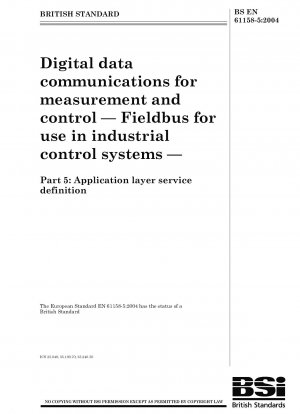BS EN 61158-5:2004
Digital data communications for measurement and control - Fieldbus for use in industrial control systems - Application layer service definition
- Standard No.
- BS EN 61158-5:2004
- Release Date
- 2004
- Published By
- British Standards Institution (BSI)
- Status
- 2009-01
- Replace By
- BS EN 61158-5-11:2008
- BS EN 61158-5-13:2008
- BS EN 61158-5-15:2008
- BS EN 61158-5-18:2008
- BS EN 61158-5-2:2008
- BS EN 61158-5-3:2008
- BS EN 61158-5-4:2008
- BS EN 61158-5-5:2008
- BS EN 61158-5-7:2008
- BS EN 61158-5-8:2008
- BS EN 61158-5-9:2008
- BS EN 61158-5-16:2008
- BS EN 61158-5-17:2008
- BS EN 61158-5-16:2009
- Latest
- BS EN 61158-5-11:2008
- BS EN 61158-5-13:2014
- BS EN 61158-5-15:2008
- BS EN 61158-5-18:2012
- BS EN 61158-5-2:2014
- BS EN 61158-5-3:2014
- BS EN 61158-5-4:2014
- BS EN 61158-5-5:2014
- BS EN 61158-5-7:2008
- BS EN 61158-5-8:2008
- BS EN 61158-5-9:2014
- BS EN 61158-5-16:2008
- BS EN 61158-5-17:2008
- BS EN 61158-5-16:2009
- Scope
- The fieldbus Application Layer (FAL) provides user programs with a means to access the fieldbus communication environment. In this respect, the FAL can be viewed as a "window between corresponding application programs." The FAL is an Application Layer Communication Standard designed to support the conveyance of time-critical and non-time-critical application requests and responses among devices in an automation environment. The term "time-critical" is used to represent the presence of an application time-window, within which one or more specified actions are required to be completed with some defined level of certainty. This standard specifies the structure and services of the IEC fieldbus Application Layer. It is specified in conformance with the OSI Basic Reference Model (ISO/IEC 7498) and the OSI Application Layer Structure (ISO/IEC 9545). FAL services and protocols are provided by FAL application-entities (AE) contained within the application processes. The FAL AE is composed of a set of object-oriented Application Service Elements (ASEs) and a Layer Management Entity (LME) that manages the AE. The ASEs provide communication services that operate on a set of related application process object (APO) classes. One of the FAL ASEs is a management ASE that provides a common set of services for the management of the instances of FAL classes. This part of IEC 61158 specifies interactions between remote applications in terms of - an abstract model for defining application resources (objects) capable of being manipulated by users via the use of FAL Services, - the primitives (interactions between the FAL and the FAL user) associated with each FAL Service; - the parameters associated with each primitive; - the interrelationship between and the valid sequences of the primitives for each service. Several models of communications are specified in this document. Each model is specifed as a communciation "type". Each type has its own separate clause in the document. Although these services specify, from the perspective of applications, how request and responses are issued and delivered, they do not include a specification of what the requesting and responding applications are to do with them. That is, the behavioral aspects of the applications are not specified; only a definition of what requests and responses they can send/receive is specified. This permits greater flexibility to the FAL users in standardizing such object behavior. In addition to these services, some supporting services are also defined in this standard to provide access to the FAL to control certain aspects of its operation.
BS EN 61158-5:2004 history
- 2009 BS EN 61158-5-11:2008 Industrial communication networks — Fieldbus specifications — Part 5-11: Application layer service definition — Type 11 elements
- 2004 BS EN 61158-5:2004 Digital data communications for measurement and control - Fieldbus for use in industrial control systems - Application layer service definition
